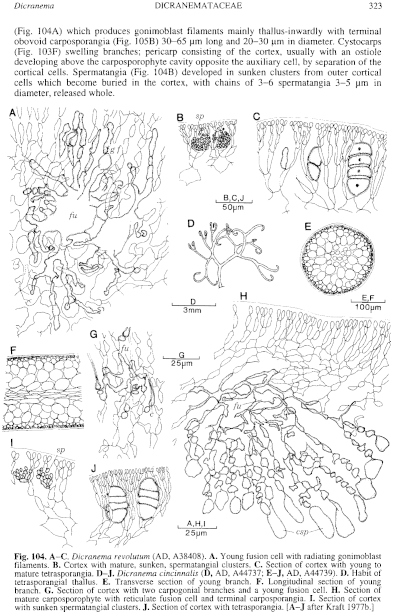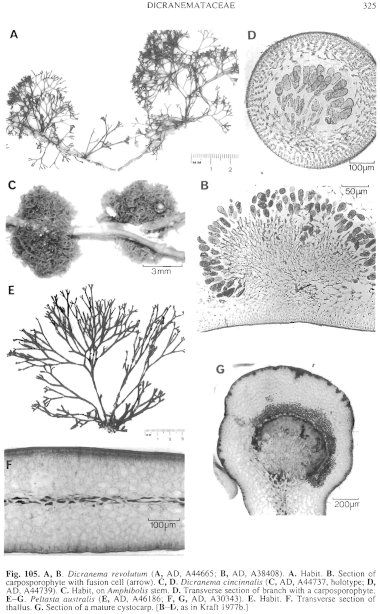|
|
|
|
|
|||||||||||
|
Electronic Flora of South Australia Species Fact Sheet
Phylum Rhodophyta – Class Florideophyceae – Order Gigartinales – Family Dicranemataceae
Synonym
D. revolutum sensu Womersley 1950: 173.
Thallus (Fig. 105C) red-brown, 3–5 mm high, cartilaginous, forming small, dense, clumps of rigid, circinnate, subdichotomous branches on stems of Amphibolis, branches terete, 200–275 µm in diameter. Holdfast discoid, crustose, 1–2 mm across, bearing numerous fronds; epiphytic. Structure multiaxial, with a medullary core (Fig. 104E, F) of elongate cells and a pseudoparenchymatous cortex of inner ovoid cells 40–80 µm in diameter and a small-celled outer cortex 2–3 cells thick, outer cells 2–3 µm in diameter.
Reproduction: Sexual thalli monoecious; non-procarpic. Carpogonial branches (Fig. 104G) 2-celled, borne on inner cortical cells near branch tips. Auxiliary cells apparently adjacent to carpogonia, fusion cell (Fig. 104G, H) diffuse, becoming reticulate, producing inwardly growing gonimoblast filaments (Fig. 105D) with single, terminal, ovoid carposporangia 25–40 µm long and 10–20 µm in diameter. Cystocarps slightly swelling branches, pericarp consisting of the cortex, ostiole absent. Spermatangia (Fig. 104I) developed in sunken clusters near branch apices, with cortical cells developing 4–6 spermatangial mother cells each with a chain of 2–3 spermatangia.
Tetrasporangial nemathecia (Fig. 104D) at branch tips, tetrasporangia (Fig. 104J) basally attached to mid cortical cells, ovoid, 50–60 µm long and 25–35 µm in diameter, zonately divided.
Type from Pennington Bay, Kangaroo I., S. Aust. (Kraft, 3.xii.1971); holotype in AD, A44737.
Selected specimens: (all on Amphibolis): Elliston, S. Aust., 7 m deep near jetty (Shepherd, 27.x.1971; AD, A42586). Tiparra Reef, S. Aust., 5 m deep (Shepherd, 19.v.1971; AD, A38580). Marino, S. Aust., 1.5 m deep (Kraft 4399, 19.i.1973; AD, A44738). D'Estrees Bay, Kangaroo I., S. Aust., outer reef pool (Womersley, 11.i.1950; AD, Al2697). Port Elliot, S. Aust., drift (Kraft, 30.iv.1971; AD, A44739). Flinders, Vic., upper sublittoral pools (Womersley, 18.i.1967; AD, A31803; Kraft, 23.xi.1976; MELU, A39568). N end Waratah Bay, Vic., upper sublittoral (Sinkora A2419, 3.iii.1978; AD, A53607).
Distribution: Elliston, S. Aust., to Flinders, Vic.
Taxonomic notes: D. cincinnalis differs from D. revolutum in its smaller size, tightly curled and densely branched habit, and reproductive details of the fusion cell, placenta and lack of an ostiole.
References:
KRAFT, G.T. (1977b). Studies of marine algae in the lesser-known families of the Gigartinales (Rhodophyta). H. The Dicranemaceae. Aust. J. Bot. 25, 219–267.
WOMERSLEY, H.B.S. (1950). The marine algae of Kangaroo Island. III. List of Species 1. Trans. R. Soc. S. Aust. 73, 137–197.
The Marine Benthic Flora of Southern Australia Part IIIA complete list of references.
Publication:
Womersley, H.B.S. (14 January, 1994)
The Marine Benthic Flora of Southern Australia
Rhodophyta. Part IIIA, Bangiophyceae and Florideophyceae (to Gigartinales)
Reproduced with permission from The Marine Benthic Flora of Southern Australia Part IIIA 1994, by H.B.S. Womersley. Australian Biological Resources Study, Canberra. Copyright Commonwealth of Australia.
Illustrations in Womersley Part IIIA, 1994: FIGS 104 D–J, 105C, D.

Figure 104 enlarge
Fig. 104. A–C. Dicranema revolutum (AD, A38408). A. Young fusion cell with radiating gonimoblast filaments. B. Cortex with mature, sunken, spermatangial clusters. C. Section of cortex with young to mature tetrasporangia. D–J. Dicranema cincinnalis (D, AD, A44737; E–J, AD, A44739). D. Habit of tetrasporangial thallus. E. Transverse section of young branch. F. Longitudinal section of young branch. G. Section of cortex with two carpogonial branches and a young fusion cell. H. Section of mature carposporophyte with reticulate fusion cell and terminal carposporangia. I. Section of cortex with sunken spermatangial clusters. J. Section of cortex with tetrasporangia. [A–J after Kraft I 977b.]

Figure 105 enlarge
Fig. 105. A, B. Dicranema revolutum (A, AD, A44665; B, AD, A38408). A. Habit. B. Section of carposporophyte with fusion cell (arrow). C, D. Dicranema cincinnalis (C, AD, A44737, holotype; D, AD, A44739). C. Habit, on Amphibolis stem. D. Transverse section of branch with a carposporophyte. E–G. Peltasta australis (E, AD, A46186; F, G, AD, A30343). E. Habit. F. Transverse section of thallus. G. Section of a mature cystocarp. [B–D, as in Kraft 1977b.]

|
Email Contact: State Herbarium of South Australia |

|